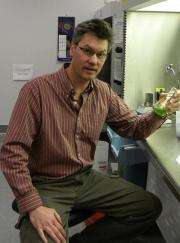Scientists unlock mystery in photosynthesis step

(PhysOrg.com) -- An international team of scientists, including two from Arizona State University, have taken a significant step closer to unlocking the secrets of photosynthesis, and possibly to cleaner fuels.
Plants and algae, as well as cyanobacteria, use photosynthesis to produce oxygen and "fuels," the latter being oxidizable substances like carbohydrates and hydrogen. There are two pigment-protein complexes that orchestrate the primary reactions of light in oxygenic photosynthesis: photosystem I (PSI) and photosystem II (PSII). Understanding how these photosystems work their magic is one of the long-sought goals of biochemistry.
The ASU scientists working with collaborators at the Max Planck Institute at Mülheim a.d. Ruhr in Germany have been investigating the PSI reaction center.
They have made an important observation that is nut-shelled in the title of a paper published in this week's online Early Edition of the Proceedings of the National Academy of Sciences (PNAS). The paper is titled "Independent initiation of primary electron transfer in the two branches of the photosystem I reaction center."
Kevin Redding, an associate professor in the department of chemistry and biochemistry in the College of Liberal Arts and Sciences, is leading the research at ASU. His lab created mutations in a single-celled green alga (Chlamydomonas reinhardtii or 'Chlamy' for short). Using these mutants, Redding and collaborators have shown that the primary light-triggered electron transfer event in the PSI reaction center can be initiated independently in each of its parallel branches. At the same time, they showed that PSI has two charge separation devices that effectively work in parallel to increase the overall efficiency of electron transfer.
"Although we knew that both branches were being used in PSI, and that our mutations had an effect upon the relative use of each pathway, what we did not know was how these mutations were having their effect," Redding explained. "Unraveling that has led to the discovery of how charge separation - the moment when electromagnetic energy is converted to chemical energy - actually occurs."
The team at the Max Planck Institute (MPI) was led by Alfred Holzwarth. His coworkers, Marc Müller and Chavdar Slavov, used lasers that sent out pulses of light lasting only 60 millionths of one billionth of a second to investigate the electron transfer processes in the two branches of PSI. This allowed them to look at extremely early events in the photosynthetic mechanism, events occurring in just a few picoseconds (a millionth of a millionth of a second), which is a time so short that a typical lattice atom could only execute a dozen oscillations on its lattice site.
This extremely sophisticated experiment and analysis required two years of laboratory effort from Rajiv Luthra, a graduate student in the Redding laboratory, to prepare a sample of sufficient purity to use. To interpret the observations, the researchers at the MPI had to develop a specific kinetic modeling approach that allowed them to estimate the individual electron transfer rates within the two branches. Comparison of mutants made in each branch with the non-mutant PSI was crucial to untangle these rates.
The current research is important for two separate reasons. Firstly, an understanding of how these complex processes work in Nature is crucial to future fundamental research in photosynthetic reaction centers, and this discovery may well be universal. Secondly, the use of two charge separation devices working cooperatively to maximize efficiency is a design theme that may well be applied in future efforts to create artificial photosynthetic devices.
Our society has urgent need of a renewable source of fuel that is widely distributed geographically, abundant, inexpensive, and environmentally clean. The use of solar energy to produce a clean fuel such as hydrogen is essentially the only process that can satisfy these criteria on a scale large enough to meet the world's energy demands. Redding is also a member of the DOE-funded Energy Frontier Research Center (led by Devens Gust, professor of chemistry and biochemistry at ASU). Its goal is to produce a clean, renewable fuel by mimicking the natural process of photosynthesis.
Provided by Arizona State University

















